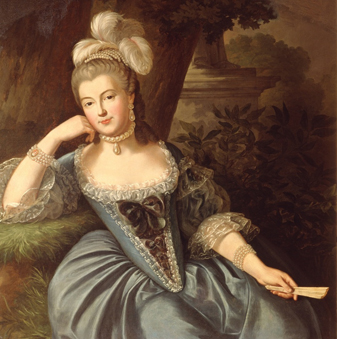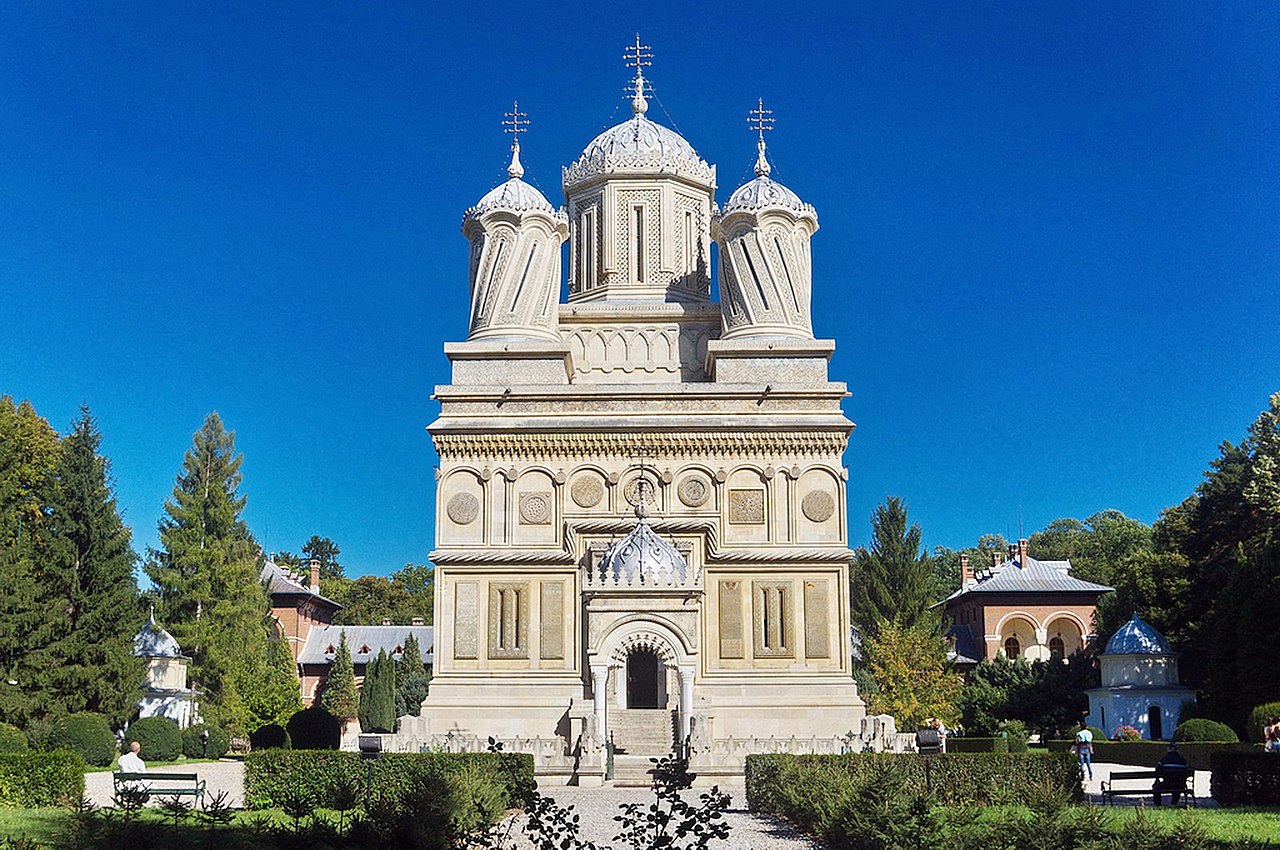by Susan Flantzer
© Unofficial Royalty 2022

Maria Caterina Brignole, Princess of Monaco; Credit – Wikipedia
The wife of Honoré III, Prince of Monaco, Maria Caterina Brignole, was born on October 7, 1737, at the Palazzo Rosso in the Republic of Genoa, now in Italy. She was the only child of Giuseppe Brignole Sale, 7th Marquis di Groppoli, an Ambassador of the Republic of Genoa to France, and Maria Anna Balbi. After the death of his brother Gian Giacomo Brignole Sale (1696 – 1734), Giuseppe married his brother’s wife Maria Anna Balbi. Maria Caterina’s parents came from two of the most powerful and wealthy families in the Republic of Genoa. Her paternal grandparents were cousins Anton Giulio II Brignole Sale, 5th Marquis of Groppoli (1673 – 1710 ), an Ambassador of the Republic of Genoa to France, and Isabella Brignole. Two of Maria Caterina’s paternal uncles had been the Doge (ruler) of the Republic of Genoa. Maria Caterina’s maternal grandparents were Francesco Maria Balbi (1671 – 1747), a Doge of the Republic of Genoa and Maria Clarice Durazzo, who also had Doges of the Republic of Genoa in her family.
Because her father was the ambassador to the French court, Maria Caterina and her mother Maria Anna took part in French high society, frequenting the salons in Paris and the Palace of Versailles. Maria Anna had several affairs including one with Honoré III, Prince of Monaco, her daughter’s future husband, and another with Louis François Armand de Vignerot du Plessis, Duke of Richelieu.

Honoré III, Prince of Monaco, first husband of Maria Caterina; Credit – Wikipedia
In 1755, a marriage was proposed between 18-year-old Maria Caterina and 35-year-old Honoré III, Prince of Monaco who was eager to marry to provide Monaco with an heir and to obtain Maria Caterina’s large dowry. However, Maria Caterina’s father opposed the marriage because of Honoré’s bad reputation and because of his fear that Honoré might inherit his fortune. In 1756, only after the intervention of King Louis XV of France and his mistress Madame de Pompadour did Maria Caternina’s father consent to the marriage.
The wedding of Honoré III and Maria Caterina was to occur on July 5, 1757, in Monaco, and it got off on a bad foot. Maria Caterina and her mother traveled to Monaco by boat accompanied by a contingent of Genovese nobility. When they arrived, Honoré did not come aboard the ship to welcome his bride. He said his status as a monarch demanded that Maria Caterina come to him. The Genovese contingent refused, saying that Maria Caterina was a member of a ruling family of the Republic of Genoa. The ship was stranded offshore for several days while a bridge was built between the port and Maria Caterina’s ship. Honoré and Maria Caterina walked towards each other at the same distance and met each other over the sea.
Honoré III and Maria Caterina had two sons:
- Honoré IV, Prince of Monaco (1758 – 1819), married Louise d’Aumont, had two sons Honoré V, Prince of Monaco and Florestan, Prince of Monaco, divorced 1798
- Prince Joseph of Monaco, Regent of Monaco (1763 – 1816), married (1) Marie Thérèse de Choiseul, had three children, Marie Thérèse was guillotined during the French Revolution (2) Frances Margaret Powell, no children

The Hôtel de Matignon, Honoré III’s Paris home; Credit – By ScareCriterion12 – Own work, CC BY-SA 4.0, https://commons.wikimedia.org/w/index.php?curid=62918157
Honoré III and Maria Caterina initially lived in Monaco but by 1760, Honoré was dissatisfied with his life there, and returned to France without his wife, spending time with his mistresses at his French homes. Eventually, Maria Caterina was allowed to come to France. She lived at the Hôtel Matignon, Honoré’s home in Paris. However, she rarely participated in social events. She spent time with Louis Joseph de Bourbon, Prince of Condé, a great-grandson of Louis XIV, King of France and his mistress Françoise-Athénaïs de Rochechouart, Marquise de Montespan. Louis Joseph’s wife Charlotte de Rohan had died in 1760. During the reigns of King Louis XV and his grandson King Louis XVI, Louis Joseph held the position of Grand Maître de France, the head of the King’s household.

Louis Joseph de Bourbon, Prince of Condé; Credit – Wikipedia
In 1765, rumors reached Honoré III that Louis Joseph was courting Maria Caterina. Being somewhat hypocritical, he left his mistress at his home in Normandy and went to Paris to scold Maria Caterina. Initially, Maria Caterina regarded Louis Joseph as just a friend, but she returned Louis Joseph’s feelings, and the two became involved in a love affair. After that, Honoré III and Maria Caterina lived separate lives with their lovers. Eventually, Maria Caterina set up a home in the Hôtel de Lassay, an annex of the Palais-Bourbon, Louis Joseph’s residence in Paris, now the meeting place of the National Assembly, the lower legislative chamber of the French Parliament.
However, in 1770, Honoré III made one last attempt to keep a hold on Maria Caterina. He planned to send Maria Caterina to Monaco and close the borders to prevent her from escaping. Before this could happen Maria Caterina left Paris to seek asylum at the Convent of the Visitation in Le Mans, France. Louis Joseph used his influence to obtain a legal separation for Maria Caterina from Honoré and the right to manage her own finances. Honoré finally realized his relationship with Maria Caterina was over and eventually accepted Maria Caterina’s relationship with Louis Joseph. There was never a divorce or annulment. Honoré continued with his mistresses and he allowed Maria Caterina to see her two sons.

Maria Caterina; Credit – Wikipedia
In 1774, Marie Antoinette, the wife of the new King of France, Louis XVI, offended Louis Joseph, who was Grand Maître de France, the head of the King’s household, by refusing to receive Maria Caterina at court due to her status as a Louis Joseph’s mistress and as a separated woman. Maria Catarina and Louis Joseph lived in France until the French Revolution. After the Storming of the Bastille in 1789, Louis Joseph fled France, before the Reign of Terror, with Maria Caterina, and his son and grandson from his first marriage.
The French Revolution had dire consequences for Honoré III and the two sons he shared with Maria Caterina. They lost all aristocratic privileges in France and were dispossessed of their French property. In January 1793, Honoré III was officially declared deposed and France annexed the Principality of Monaco. During the Reign of Terror, in September 1793, Honoré III was arrested and imprisoned in Paris. Maria Catarina and Honoré III’s son Honoré (IV) was also arrested as were Honoré (IV)’s wife Louise d’Aumont and his son Florestan. Honoré (IV) was released after fifteen months in prison and his wife and son were saved by their family doctor.
However, Maria Catarina’s daughter-in-law, the wife of her son Joseph, was not as lucky. Joseph spent most of his time abroad negotiating foreign loans, making him a suspect of counter-revolutionary activities. Joseph did become involved in a counter-revolution in Vendée. His wife Marie Thérèse was arrested in the absence of her husband, condemned to death, and guillotined in 1794, one of the last victims before the end of the Reign of Terror.
Honoré III was eventually released from prison. He died soon afterward in Paris on March 21, 1795, at the age of 74, but his burial place is unknown. Following the defeat of Napoleon I, Emperor of the French in 1814, Maria Catarina’s son Honoré IV, aged 56 and in ill health since his imprisonment during the Reign of Terror, returned to Monaco where he reigned as Sovereign Prince until he died in 1819.

The Army of Condé; Credit – Wikipedia
As for, Maria Caterina and Louis Joseph, after they fled France, they settled in Koblenz in the Electorate of Saxony, now in the German state of Rhineland-Palatinate. Koblenz became the home of many royalist émigrés who had fled France. Louis Joseph helped to organize and lead a counter-revolutionary army of émigrés called the Army of Condé. Maria Caterina used her fortune to help finance the exiled French community’s armed resistance. In 1792, the émigrée court at Koblenz was dissolved and Maria Caterina and Louis Joseph left for Great Britain.

Saint Aloysius Catholic Church in London, England where Maria Caterina is buried; Credit – https://www.british-history.ac.uk/survey-london/vol24/pt4/plate-86
Three years after the death of Honoré III, Maria Caterina and Louis Joseph were married on October 24, 1798, in London, England. Their marriage was kept secret for ten years and was not revealed until December 26, 1808. Maria Caterina, aged 76, died in Wimbledon, England on March 18, 1813, and was buried at Saint Aloysius Catholic Church in London, England, founded by Guy-Toussaint-Julien Carron, a French priest who had settled in England having fled the French Revolution.

Louis Joseph de Bourbon, Prince of Condé; Credit – Wikipedia
After the defeat of Napoleon I, Emperor of the French in 1814, the Bourbon Restoration saw a younger brother of the beheaded King Louis XVI become King Louis XVIII of France. Louis Joseph returned to France and at the age of 78, resumed his duties as Grand Maître de France, in the household of King Louis XVIII. Louis Joseph survived Maria Caterina by five years, dying on May 13, 1818, at the Palais-Bourbon in Paris, France, aged 81. He was buried at the Basilica of St. Denis in St. Denis, France, near Paris.
This article is the intellectual property of Unofficial Royalty and is NOT TO BE COPIED, EDITED, OR POSTED IN ANY FORM ON ANOTHER WEBSITE under any circumstances. It is permissible to use a link that directs to Unofficial Royalty.
Works Cited
- Edwards, Anne, 2017. The Grimaldis of Monaco. Blue Ridge Summit: Lyons Press.
- En.wikipedia.org. 2022. Louis Joseph, Prince of Condé – Wikipedia. [online] Available at: <https://en.wikipedia.org/wiki/Louis_Joseph,_Prince_of_Cond%C3%A9> [Accessed 13 March 2022].
- En.wikipedia.org. 2022. Maria Caterina Brignole – Wikipedia. [online] Available at: <https://en.wikipedia.org/wiki/Maria_Caterina_Brignole> [Accessed 8 March 2022].
- Flantzer, Susan, 2022. Honoré III, Prince of Monaco. [online] Unofficial Royalty. Available at: <https://www.unofficialroyalty.com/honore-iii-prince-of-monaco/> [Accessed 13 March 2022].
- geni_family_tree. 2022. Marie-Catherine Brignole, Princesse de Monaco. [online] Available at: <https://www.geni.com/people/Marie-Catherine-Brignole-Princesse-de-Monaco/5294696734550123378> [Accessed 13 March 2022].















